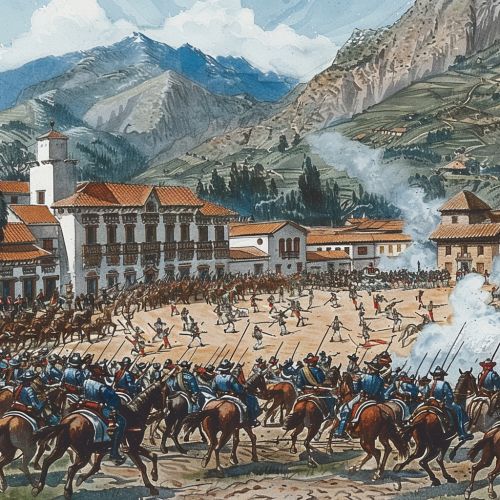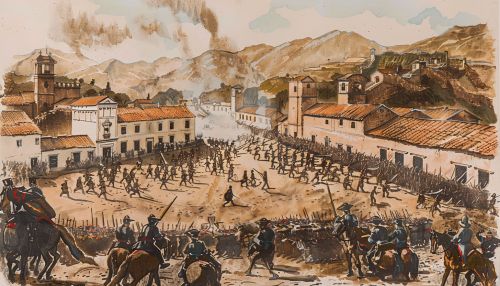Battle of Cajamarca: Difference between revisions
(Created page with "== Background == The '''Battle of Cajamarca''' was a pivotal moment in the Spanish conquest of the Inca Empire. It occurred on November 16, 1532, when a small Spanish force led by Francisco Pizarro ambushed and captured the Inca Emperor Atahualpa in the town of Cajamarca, located in present-day Peru. This event marked the beginning of the end for the Inca Empire and significantly altered the course of South American history. == Prelude to the Battle == ===...") |
No edit summary |
||
| Line 23: | Line 23: | ||
On November 16, 1532, Pizarro and his 168 men entered Cajamarca. They set up an ambush in the town square, hiding their cavalry and artillery in nearby buildings. Atahualpa, confident in his numerical advantage, entered the square with a retinue of unarmed nobles and attendants. | On November 16, 1532, Pizarro and his 168 men entered Cajamarca. They set up an ambush in the town square, hiding their cavalry and artillery in nearby buildings. Atahualpa, confident in his numerical advantage, entered the square with a retinue of unarmed nobles and attendants. | ||
[[Image:Detail-91793.jpg|thumb|center|Illustration of the Battle of Cajamarca, showing Spanish soldiers ambushing the Inca forces in the town square.|class=only_on_mobile]] | |||
[[Image:Detail-91794.jpg|thumb|center|Illustration of the Battle of Cajamarca, showing Spanish soldiers ambushing the Inca forces in the town square.|class=only_on_desktop]] | |||
=== The Capture of Atahualpa === | === The Capture of Atahualpa === | ||
Latest revision as of 15:21, 19 June 2024
Background
The Battle of Cajamarca was a pivotal moment in the Spanish conquest of the Inca Empire. It occurred on November 16, 1532, when a small Spanish force led by Francisco Pizarro ambushed and captured the Inca Emperor Atahualpa in the town of Cajamarca, located in present-day Peru. This event marked the beginning of the end for the Inca Empire and significantly altered the course of South American history.
Prelude to the Battle
Political Context
The Inca Empire, known as Tawantinsuyu, was the largest empire in pre-Columbian America. By the early 16th century, it was embroiled in a civil war between two brothers, Atahualpa and Huáscar, who vied for the throne after the death of their father, Huayna Capac. Atahualpa eventually emerged victorious, but the empire was weakened by the conflict.
Spanish Exploration
The Spanish, driven by the promise of wealth and glory, had been exploring the New World since the late 15th century. Francisco Pizarro, a seasoned conquistador, had previously undertaken expeditions along the western coast of South America. In 1531, he embarked on a final expedition with the explicit goal of conquering the Inca Empire.
The Encounter at Cajamarca
Initial Contact
Pizarro and his men first made contact with Inca emissaries in the coastal town of Tumbes. The Spaniards were invited to meet Atahualpa, who was encamped in Cajamarca with a large army. Despite being vastly outnumbered, Pizarro decided to proceed with the meeting, hoping to exploit the element of surprise and the technological superiority of his forces.
The Ambush
On November 16, 1532, Pizarro and his 168 men entered Cajamarca. They set up an ambush in the town square, hiding their cavalry and artillery in nearby buildings. Atahualpa, confident in his numerical advantage, entered the square with a retinue of unarmed nobles and attendants.


The Capture of Atahualpa
The Spaniards initiated the attack with a cannon shot, which caused panic among the Inca. The cavalry charged, and the infantry, armed with swords and firearms, swiftly overwhelmed the unarmed Incas. Atahualpa was captured in the chaos, marking a decisive victory for the Spanish.
Aftermath
Ransom and Execution
Atahualpa, in an attempt to secure his release, offered to fill a room with gold and silver as ransom. The Spaniards accepted the offer, and over the next few months, vast amounts of treasure were amassed. Despite fulfilling his promise, Atahualpa was executed by the Spanish in July 1533, accused of plotting against them.
Collapse of the Inca Empire
The capture and execution of Atahualpa left the Inca Empire leaderless and demoralized. Pizarro and his men continued their conquest, facing sporadic resistance but ultimately succeeding in subjugating the empire. By 1535, the Spanish had established control over most of the Inca territories.
Significance
The Battle of Cajamarca was a turning point in the Spanish conquest of the Inca Empire. It demonstrated the effectiveness of European military technology and tactics against indigenous forces. The capture of Atahualpa and the subsequent acquisition of vast amounts of gold and silver significantly boosted the Spanish economy and fueled further expeditions in the New World.
